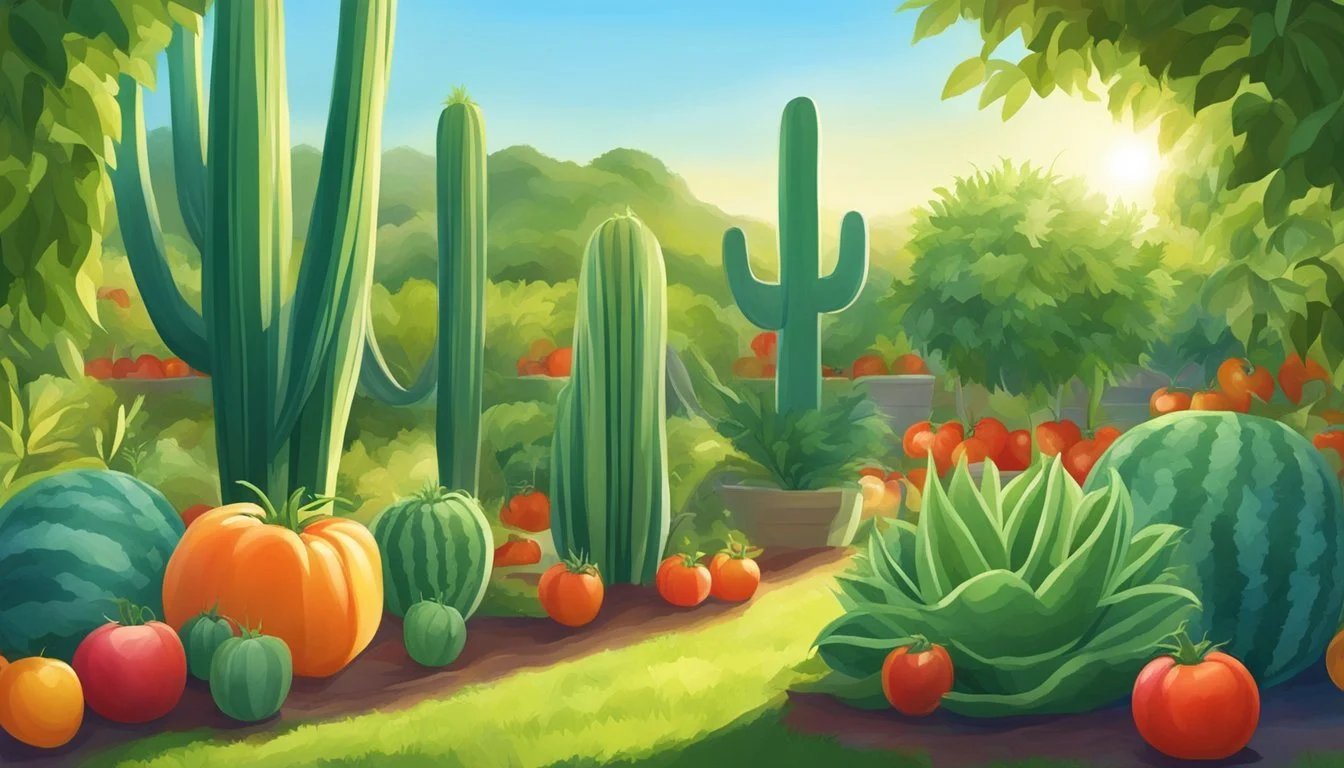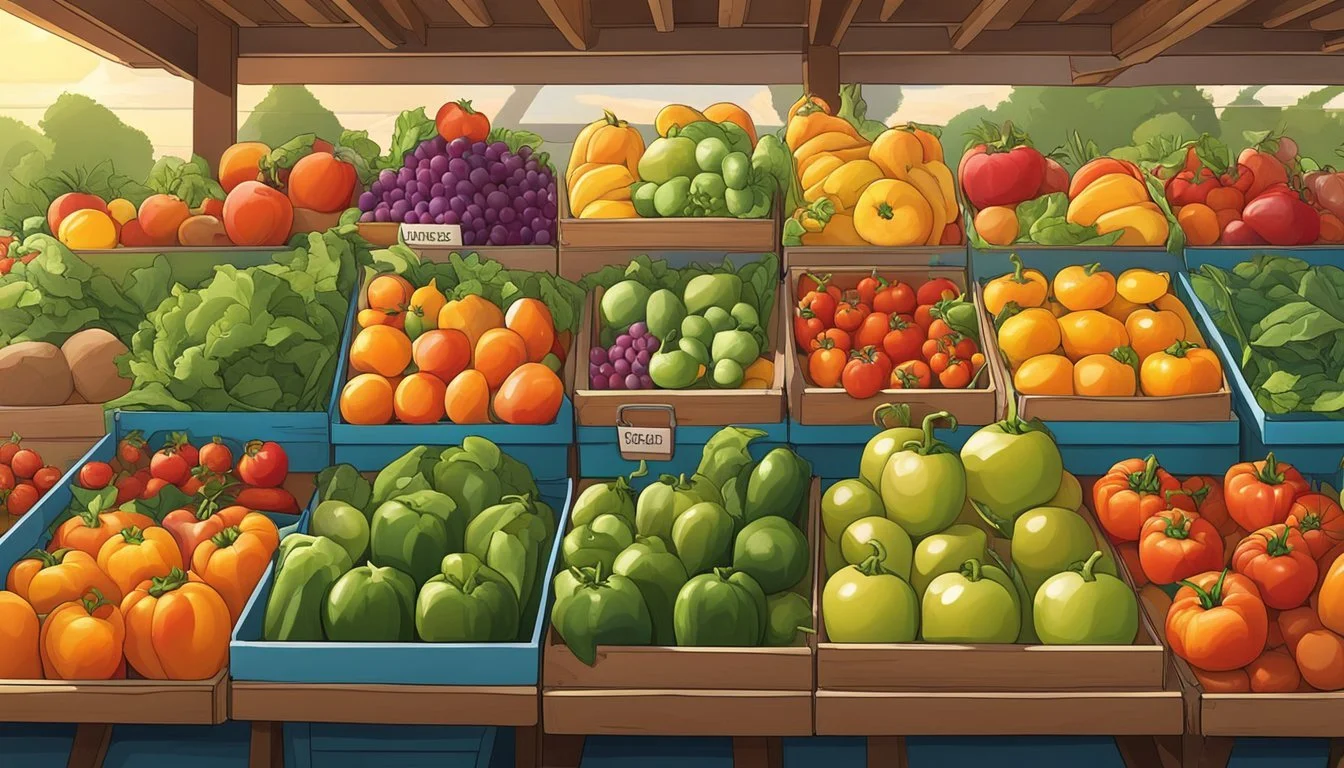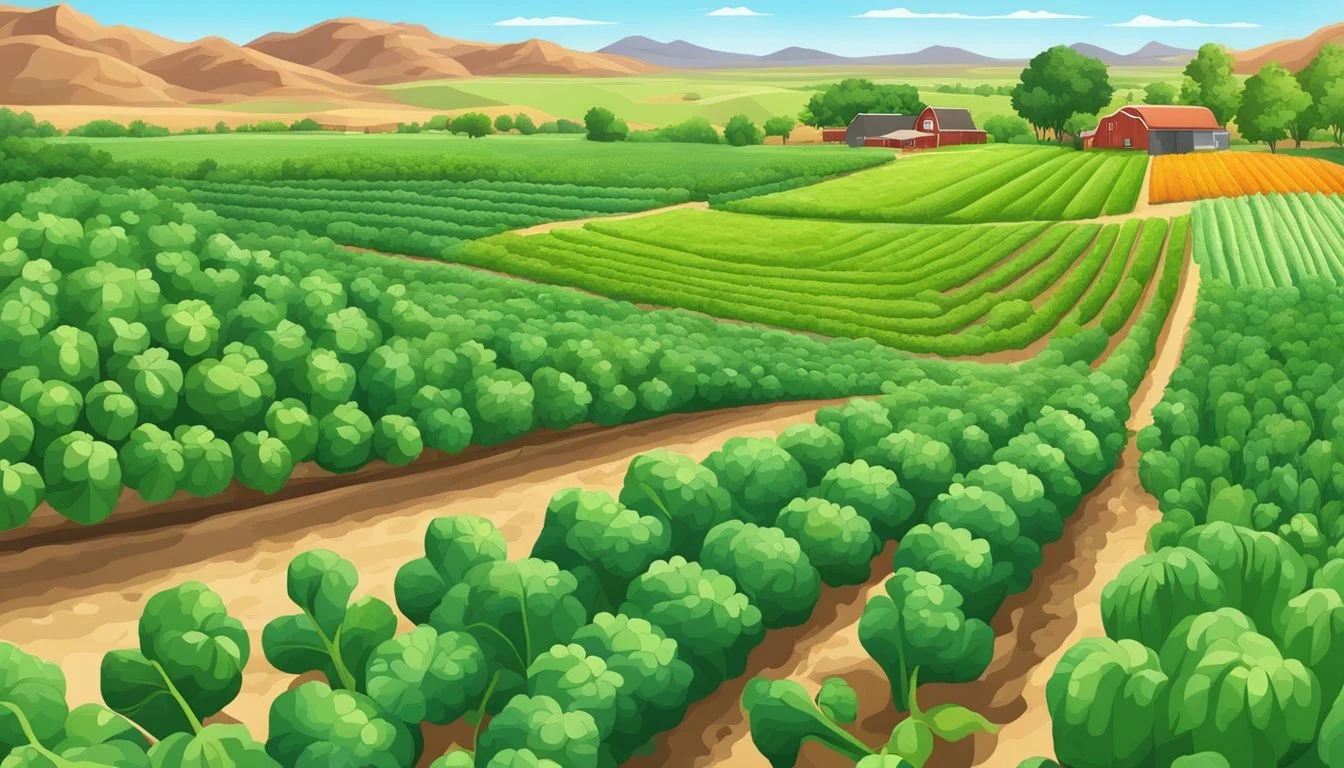Arizona Seasonal Fruit & Vegetables in June
A Guide to Fresh Produce
This Article is Part of our Arizona Seasonal Fruit & Veg Calendar
In June, Arizona's agricultural landscape ushers in the start of summer by offering a variety of fresh, seasonal produce. As the temperature climbs, the harvest reflects the shifting climate with an abundance of warm-weather fruits (What wine goes well with fruits?) and vegetables that thrive in the state's unique conditions. While the state is commonly associated with its year-round sunny skies, the diverse geography from desert to plateau imparts a distinct growth pattern for local produce.
Seasonal eating supports local farming and provides consumers with the freshest and most flavorful fruits and vegetables. In Arizona, June welcomes the peak season for several types of produce. Fruit enthusiasts can enjoy the sweet taste of blackberries and the tail end of the blueberry season. The month also marks the availability of stone fruits such as apricots, which are celebrated for their vibrant flavor and juicy texture during this time.
For vegetables, the month of June in Arizona sees a range of colorful and nutritious options. Sweet corn begins to make its appearance, along with various types of squash and cucumber that are perfect for summer dishes. These are not only peak picks for quality but also for nutritional content, as vegetables harvested in their prime contain more vitamins and minerals. Eating with the seasons thus provides the opportunity to enjoy produce at its most delectable state while also benefiting from its optimal nutritional profile.
Overview of Arizona's Seasonal Fruits and Vegetables
In Arizona's dry and warm climate, June marks the tail end of the spring harvest and the beginning of summer bounty. This transition period sees a variety of fruits and vegetables that are in season, providing fresh and flavorful produce.
Fruits:
Blueberries: These berries reach their peak in early June, offering a sweet and tangy flavor.
Citrus fruits, such as lemons and oranges, are nearing the end of their season but can still be found fresh.
Melons: They start to make their appearance, promising refreshing tastes amidst the rising temperatures.
Vegetables: A number of hearty vegetables remain in season through June in Arizona, including:
Beets, with their earthy sweetness, can be enjoyed raw or cooked.
Chard, which provides a nutritious boost to meals with its leafy greens and colorful stems.
Garlic is harvested and is perfect for enhancing many dishes.
While the summer heat is setting in, Arizona's unique growing conditions still allow for a range of produce to flourish. Consumers can find these fresh fruits and vegetables at local farmers markets, ensuring they are getting the season's best offerings. By prioritizing in-season produce, individuals not only enjoy optimal flavors but also support sustainable agricultural practices within Arizona.
Prime Fruits to Enjoy in June
In Arizona, June marks the availability of numerous fresh fruits that are both flavorful and nutrient-rich. This month, stone fruits reach their prime, berries burst with flavor, and melons begin to sweeten under the summer sun.
Stone Fruits
Apricots: These small, golden fruits have a limited season and June is the prime time to enjoy their sweet, yet slightly tart flavor.
Peaches: With their juicy flesh and sweet aroma, peaches are a staple of Arizona's June produce.
Berries
Blueberries: Early June is typically the tail end of blueberry season in Arizona, offering sweet and tangy berries perfect for snacking or baking.
Strawberries: Although their peak starts earlier in spring, strawberries can still be enjoyed for their sweetness and versatility.
Melons
Melons: Various types of melons begin to come into season, offering a refreshing and hydrating treat during Arizona’s warm June days.
Fresh Vegetables Harvested in June
June in Arizona marks the abundance of various vegetables across the state's farms and gardens. This time of year offers a variety of fresh produce, each bursting with flavor and nutrition.
Leafy Greens and Salad Staples
Arugula (how long does arugula last?) and other leafy greens flourish in the warm early summer climate of Arizona. Shoppers can find locally grown arugula alongside staples like lettuce, which remains crisp and tender during this month. One can expect to include these greens in a variety of salads and dishes.
Arugula
Lettuce
Roots and Bulbs
As June's warmth progresses, root vegetables and bulbs begin to reach their peak. Sought after by chefs and home cooks alike, onions—particularly sweet varieties—are harvested during this period, adding a mild, sweet flavor to dishes.
Onions (Sweet varieties)
Podded Vegetables
Podded vegetables, which include a variety of beans, are a key group of vegetables that come into season in June. Green beans stand out with their crunchy texture and are a versatile ingredient perfect for both light summer dishes and hearty meals.
Green beans
Summer Squash Varieties
June also signals the arrival of summer squash, which includes a range of types that are tender and ideal for quick cooking methods. Varieties like zucchini (What wine goes well with zucchini?) can be found in abundance and are a favorite for grilling or as an addition to vibrant summer dishes.
Zucchini
Other summer squash varieties
Planning Your Garden for Summer Harvest
June in Arizona presents a unique set of challenges and opportunities for gardeners aiming for a productive summer harvest. The state's intense heat demands careful selection of plant varieties suited to thrive in high temperatures.
Plant Selection: Gardeners should focus on heat-loving plants. A variety of peppers, such as bell peppers, habanero, and Serrano, are robust choices for June planting. These varieties not only endure the heat but also continue producing through the summer.
Planting Schedule:
Early June: This is the time to ensure heat-tolerant vegetables are well-established.
Mid to Late June: Transition to planting sun-loving ornamentals and succulents such as aloe, bougainvillea, and lantana.
Garden Maintenance:
Water Requirements: It's essential to maintain consistent and deep watering practices to support plant health. Adapt irrigation schedules to account for increased evaporation.
Shade Protection: To shield plants from the most extreme heat, employ shade cloths strategically throughout the garden, particularly for plants that are less tolerant of direct sunlight.
Pest Control: Warm weather can lead to increased insect activity. Regularly inspect plants for pests and use appropriate, environmentally responsible methods for control.
In summary, the success of a June garden in Arizona depends on careful plant selection, adjusted planting schedules, diligent watering, protection from heat, and pest management. A gardener in Arizona can confidently expect a bountiful summer harvest by attending to these factors.
Nutritional Benefits of June Produce
June's seasonal produce in Arizona provides a bounty of nutritional advantages. These fruits and vegetables are at their peak, offering rich concentrations of vitamins, minerals, and dietary fiber essential for maintaining good health.
Vitamins and Minerals
June's seasonal fruits like berries and melons are abundant in Vitamin C, vital for immune function and skin health. Sweet corn, a June vegetable, is a good source of Vitamin B variants that support metabolism and energy production. In general, Arizona's June produce supports a variety of bodily functions due to its wealth of essential nutrients.
Fruit Examples:
Berries (strawberries, cherries): Rich in Vitamin C and K
Melons (watermelon, cantaloupe (how long does cantaloupe last?)): High in Vitamin A and C
Vegetable Examples:
Summer squash: Contains Vitamin B6 and K
Sweet corn: Offers Vitamins B and C
Dietary Fiber
The fiber content in seasonal vegetables like summer squash and beans is beneficial for digestion and can help to regulate blood sugar levels. They also contribute to a feeling of fullness, supporting weight management. Additionally, fiber is known for its role in cholesterol management, which can be beneficial for cardiovascular health.
Fruit Examples:
Berries: Provide a significant amount of fiber in a naturally sweet package.
Vegetable Examples:
Beans: Are a high-fiber choice that can enhance fullness and digestion.
Summer squash: Offers dietary fiber without a high calorie count.
Recipes and Preparation Ideas
June in Arizona brings a bounty of fresh produce, perfect for vibrant salads, hearty main courses, and delightful desserts. Utilizing these in-season fruits and vegetables encourages the creation of dishes that are both flavorful and nutritious.
Salads and Starters
Fresh salads make the most of June's produce, like sweet onions, and a variety of peppers. They suggest a Grilled Pepper and Sweet Onion Salad - a mix of charred peppers and onions atop a bed of fresh greens, dressed with a citrus vinaigrette. Another starter to consider is a Chilled Cucumber Soup that plays up the refreshing qualities of cucumbers (how long do cucumbers last?), amplified with a hint of mint, another June green.
Main Courses
For the main course, they recommend incorporating zucchini and tomatoes, which are abundant in June. One can prepare Roasted Zucchini and Tomato Pasta, where the vegetables are roasted to concentrate their flavors before being tossed with al dente pasta and fresh basil (how long does basil last?). For a heartier dish, they suggest Stuffed Bell Peppers (What wine goes well with stuffed bell peppers?) filled with a mix of ground meat, cooked grains, and diced June vegetables, topped with melted cheese.
Desserts
When it comes to desserts, pies are a beloved choice. They can opt for a Classic Peach Pie using fresh, ripe peaches that are in season. Alternatively, a more adventurous cook might experiment with a Tangerine Sorbet, which would offer a refreshing, icy treat to combat the Arizona heat, showcasing the citrus notes of in-season tangerines.
Preserving the Bounty of June
In Arizona, June brings an abundance of fruits and vegetables ripe for preservation. As these items peak in freshness, effective methods of storage ensure their longevity beyond the season. Freezing is a reliable technique for squashes harvested daily in Arizona. Sliced and blanched squash can be frozen in a single layer and then stored in freezer-safe bags or containers. This method retains flavor and nutrition well.
Peppers, including bell and various hot varieties, also thrive in June's warm climate. After harvesting, they can be preserved through drying or freezing. When freezing peppers, one can slice them into pieces, flash freeze them on a tray, and transfer them to airtight containers. This practice seals in their crisp taste and vibrant color for future culinary uses.
Storage consideration is paramount for preserving the integrity of June's harvest. Cooled, dry, and dark environments are ideal for prolonging the shelf life of dried and canned goods. Moisture control is crucial in preventing mold growth and maintaining quality.
Preservation doesn't stop at cold storage; dehydration is a practical approach for Arizona's June yield, especially for herbs like basil, which can be dried and stored for extended use. Drying concentrates the flavors, making them a convenient boost for year-round cooking.
Below is a table summarizing June's bounty and corresponding preservation methods:
Fruit/Vegetable Preservation Method Squash Freezing Peppers Freezing, Drying Basil Drying, Freezing in oil
Utilizing these preservation techniques secures a bit of June's freshness for the months to come.
Supporting Local Arizona Farms
When seeking fresh produce in Arizona, turning to local farms is a sustainable choice that bolsters the community. Arizona produce is abundant and diverse, offering a range of fruits and vegetables that are especially fresh and flavorful when sourced locally.
Local Arizona farms can typically provide a list of their in-season offerings, where June brings an array of produce. Consumers can support these farms by visiting community-supported agriculture (CSA) programs and farmers markets. Tucson CSA, for instance, promotes an essential connection between local producers and consumers, furthering a sustainable food system in the region.
Farmers Markets
City Market Name Days Open Tucson Tucson Farmers Market Sat, Sun Phoenix Uptown Farmers Market Wed, Sat Mesa Mesa Community Market Fri
Local restaurants also play a vital role by incorporating farm-to-table practices, ensuring their dishes feature the freshest ingredients while supporting Arizona’s agricultural economy. Dining at establishments like Joe’s Farm Grill provides a dual benefit of enjoying fresh fare while also contributing to the livelihood of Arizona farmers.
Local Produce Calendar
Citrus: Oranges, Lemons, Grapefruits (In-season until May)
Berries: Raspberries, Blueberries (Begin in late spring)
To stay informed and support Arizona farms, one can follow their social media platforms or visit their websites. This provides updates on available produce, special events, and how to best access their fresh goods. By making intentional purchasing decisions, individuals can have a tangible impact on the success of local farms and the robustness of the community.
Seasonal Eating Through the Year in Arizona
In Arizona, seasons dictate a rich diversity of local produce, making seasonal eating a vibrant and health-conscious choice. The state's unique climate with hot summers and mild winters provides an almost year-round growing season for a wide variety of fruits and vegetables.
Spring
During the early spring months in Arizona, the following in-season produce begins to peak:
Asparagus
Beets
Broccoli
Cabbage
Cauliflower
Carrots
Celery
Lemons
Oranges
Spinach
Strawberries
By late spring, the selection expands, and fresher, tender produce hits the market.
Summer
Summer brings intense heat to Arizona, but it's a great season for many fruits and vegetables to thrive. Some summer favorites include:
Melons
Sweet Corn
Cucumbers
Peppers
Eggplant
Tomatoes
These items are often at their peak and provide freshness and flavor to any summer meal.
Autumn
As the temperatures begin to cool, Arizona's autumn produce offers a new palate of flavors. Harvest includes:
Apples
Squashes
Pomegranates
Greens
Autumn also brings about the end of some summer crops while introducing heartier vegetables that can withstand cooler temperatures.
Winter
Arizona's winter months are far from barren and still yield a bountiful array of produce. Winter favorites include:
Citrus fruits like oranges and lemons
Root vegetables such as beets and carrots
Leafy greens, including spinach and different varieties of lettuce
These crops enjoy the cooler weather and provide a fresh bounty throughout the season.









